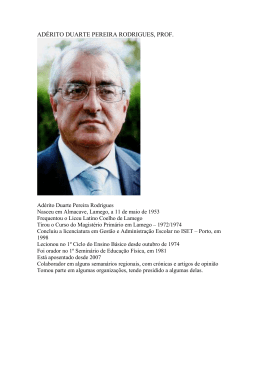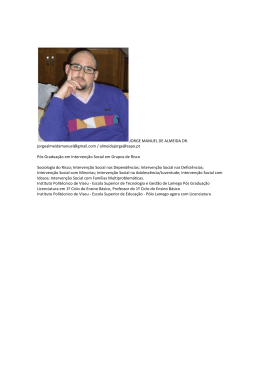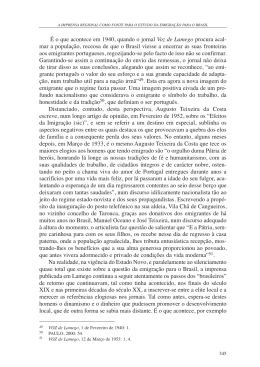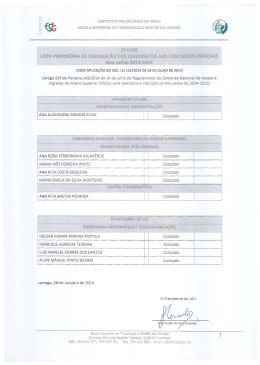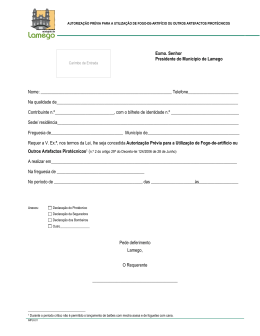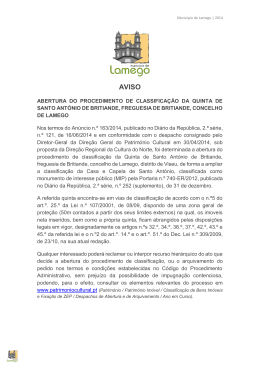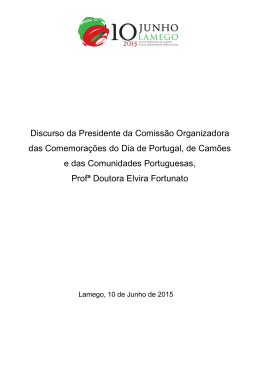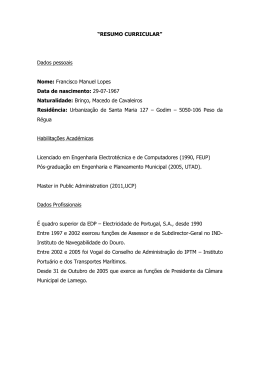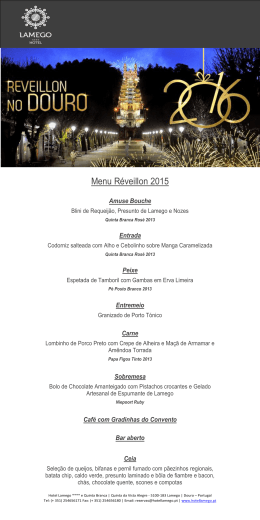ÍNDICE INDEX Historial 03 Background Património 06 Heritage Museus 14 Museums Natureza e Lazer 17 Nature and Leisure Artesanato 19 Craftsmanship Gastronomia 20 Gastronomy Vinhos 25 Wines Eventos Culturais, Feiras e Festas 26 Cultural Events, Fairs & Festivals Alojamento 28 Accommodation Bares e Discotecas 31 Pubs & Discos Equipamentos 31 Facilities Viagens 34 Travel Contactos 36 Contacts lamego_apos_prova_correcoes.indd 1 26/08/14 12:55 HISTORIAL BACKGROUND Cidade antiquíssima, datando já do tempo dos romanos, foi reconquistada definitivamente em 1057 por Fernando Magno de Leão aos mouros; quando os distritos foram instituídos em 1835 por uma reforma de Mouzinho da Silveira, Lamego foi inicialmente prevista como sede de distrito; mas nesse mesmo ano a sede do mesmo foi deslocada para Viseu, devido à sua posição mais central. Foi em Lamego que teriam decorrido as lendárias Cortes de Lamego, onde teria sido feita a aclamação de D. Afonso Henriques como Rei de Portugal e se estabeleceram as “Regras de Sucessão ao Trono”. É sede da diocese de Lamego (a única diocese portuguesa que não corresponde a uma capital de distrito), e no concelho são numerosos os monumentos religiosos, dos quais se destacam a Sé Catedral, a Igreja de São Pedro de Balsemão e o Santuário da Nossa Senhora dos Remédios, que dá também o nome a Romaria anual cujo dia principal é o 8 de Setembro, que é também o feriado municipal. Conhecida também pela sua gastronomia, nas qual se destacam os seus presuntos, o “cabrito assado com arroz de forno” e pela produção de vinhos, nomeadamente vinho do Porto, de cuja Região Demarcada faz parte, e pelos vinhos espumantes. Perde-se na bruma do tempo a origem de LAMEGO. Segundo o autor Pina Manique e Albuquerque citado pelo historiador Gonçalves da Costa (1977, p. 45, vol.1), “ o topónimo “Lamego” compõe-se dum radical lígure ou ambro-ilírio Lam, e o sufixo aecus, revelador dum gentílico. Lamaecus era, pois, o nome dum possessor dum fundo agrário hispano -romano, instituído no séc. III junto ao burgo que se ia desenvolvendo à roda do castelo...” As Inquirições Afonsinas (século XIII) citam o Castro de Lameco como sinónimo de uma fortificação medieval. Destruída pelos romanos, os habitantes tiveram que descer dos seus abrigos alcantilados para se dedicarem ao cultivo das terras, influenciados pela civilização de Roma. Lamego torna-se cristã quando o rei dos Visigodos Recaredo I se converte ao Cristianismo. Em 570, no Concílio de Lugo, aparece-nos referenciado Sardinário como Bispo de Lamego. O rei visigodo Sisebuto, durante o seu reinado entre o ano de 612 e 621, cunha aqui moeda, o que atesta bem da importância comercial, cultural e histórica de Lamego. Em 1128, no alvor da nacionalidade, o aio do nosso primeiro rei, D. Egas Moniz, tem a tenência de Lamego e residência em Britiande, ficando senhor de Riba–Douro, entre o Paiva e o Távora, alcançando ainda terras de Côa. D. Sancho I concedeu-lhe carta de couto em 1191. Lamego foi crescendo à volta de dois polos: Sé e Castelo. Em 1290, D. Dinis deu carta de feira à cidade (Viterbo, 1962), chegando a vir mercadores de Castela e de Granada, comercializando as especiarias e os tecidos orientais. Durante o séc. XV fruiu as vantagens de uma situação privilegiada, numa das mais concorridas vias de trânsito do Ocidente da Península, ligando as cidades de Além-Douro, Braga e Guimarães, por Alcântara e Mérida a Córdova e a Sevilha. Rota preferida na Ro- lamego_apos_prova_correcoes.indd 3 LAMEGO / 3 26/08/14 12:56 magem a Compostela (Albuquerque, 1986). No entanto, dois importantes acontecimentos fizeram mudar completamente a vida económica e social desta região: a conquista de Granada que lançou fora da Península os últimos mouros, levando consigo o ânimo comercial; e a descoberta do caminho marítimo para a Índia, enfraquecendo todo o comércio de Lamego. D. Manuel outorgou-lhe foral novo em 1514. Ainda durante o séc. XVI é nomeado bispo de Lamego D. Manuel de Noronha, um dos mais notáveis prelados de Lamego. Ocupando a mitra durante dezoito anos, foi apelidado “o grande construtor” e é com ele que começa verdadeiramente o culto a Nossa Senhora dos Remédios. Nos séculos XVII e XVIII começam a ser construídos, em Lamego, os solares, a que não é certamente alheio o incremento do comércio do vinho generoso do Douro e a proteccão que lhe foi dada pelo Marquês de Pombal com a criação da Região Demarcada do Douro e Companhia Geral da Agricultura das Vinhas do Alto Douro. Na segunda metade do século XIX, sob a presidência do Visconde Guedes Teixeira, Lamego conhece o caminho da modernização com a abertura de novas avenidas, ainda hoje consideradas as mais importantes da cidade. Lamego é um importante e incontornável centro histórico e cultural do Douro, e por isso convidamo-lo para um Encontro com a HISTÓRIA. Dating back to the Roman Era, the age-old city of Lamego was finally reconquered from the Moors by Ferdinand I of León and Castile in 1057. Upon the creation of districts through a reformation introduced by Mouzinho da Silveira in 1835, and in spite of the fact that Lamego was meant to be district capital, the city of Viseu won that status due to its more central position. It is said that Lamego was the place for the legendary Courts of Lamego, at which Dom Afonso Henriques would have been declared first King of Portugal and the “Rules for the Succession to the Throne” were established. As seat of the Diocese of Lamego (the only Portuguese diocese that doesn’t correspond to a district capital), there are several religious monuments around the municipality, of which the most noteworthy are the Cathedral, the Church of São Pedro de Balsemão and the Sanctuary of Nossa Senhora dos Remédios. The annual religious festival that takes place on the 8th September, also the main local holiday, is named after the later. It is also well known for its gastronomy – especially for the cured ham and the roast kid with oven baked rice – and wine production – namely Port Wine, whose Demarcated Region it belongs to –, as well as sparkling wines. The origins of the place name LAMEGO are lost in the mists of time. According to the author Pina Manique e Albuquerque, quoted by the historian Gonçalves da Costa (1977, pp. 45, vol. 1), the place name is composed of the Ligurian or Ambro-Illyrian root “Lam” and the suffix “aecus”, which denotes a demonym. Lamaecus was therefore the name of an Hispanic-Roman estate’s owner established in the 3rd century next the burg that was evolving around the castle…” The Lameco Hill Fort is referred to as a medieval fortification in the Afonsine Inquiries (13th 4 / LAMEGO lamego_apos_prova_correcoes.indd 4 26/08/14 12:56 century). Destroyed by the Romans, its inhabitants had to come down from their craggy shelters and embrace agriculture by influence of Rome. Lamego became a Christian city when Reccared I, King of the Visigoths, converted to Christianity. In 570, in the Council of Lugo, Sardinário was referenced as to Bishop of Lamego. During his reign between 612 and 621, it is known that the Visigoth King Sisebut minted coins in Lamego, which reinforces the commercial, cultural and historical importance of the city. In 1128, during the early days of the nation, Dom Egas Moniz – our first king’s tutor – was offered the tenancy of Lamego and established himself in Britiande, becoming lord of the Riba-Douro region which extended from between the rivers Paiva and Távora to the lands of Côa. In 1191, Lamego was granted a charter of “couto” – which bestowed immunity from the royal justice and taxes – by Dom Sancho I and began to expand around two poles: the See and the Castle. In 1290, the city was then granted a charter of fair (Viterbo, 1962) – which conceded special trade privileges – that even attracted merchants from Castile and Granada who brought spices and oriental fabrics. Throughout the 15th century, Lamego enjoyed the benefits of being positioned on one of the most important transit routes in the West of the Iberian Peninsula – which connected the Além-Douro cities of Braga and Guimarães to the now Spanish south-eastern cities of Córdova and Seville through Alcántara and Mérida – and the one preferred by pilgrims on their way to Santiago de Compostela (Albuquerque, 1986). However, two major events completely changed the region’s economic and social life: the conquest of Granada – which banned the last Moors and their trading morale from the Peninsula – and the discovery of the sea route do India, which weakened the trade in Lamego. In 1514, Lamego was finally granted the municipality charter by Dom Manuel. In the same century, Dom Manuel de Noronha – one of the city’s most notable prelates – was appointed Bishop of Lamego. Nicknamed as “the great constructor”, he wore the mitre for about eighteen years and was the one who truly initiated Nossa Senhora dos Remédios’ worship. The growing trade of fortified wine from the Douro and the protection it was given by the Marquis of Pombal with the establishment of the Douro Demarcated Region and the Companhia Geral da Agricultura das Vinhas do Alto Douro prompted the construction of several manor houses in Lamego during the 17th and 18th centuries. In the second half of the 19th century, under the presidency of Visconde Guedes Teixeira, Lamego found its way into modernisation with the construction of new avenues which are still considered the most important ones in the city. Lamego is an important and essential historic and cultural centre in the Douro Region, and for this reason we invite you to a Date with HISTORY. Segundo os dados apresentados pelo Instituto Nacional de Estatística, com base nos Censos 2011, actualizados em 2013 / According to the data submitted by the National Statistical Institute, based on the 2011 Census, updated in 2013: População Residente no Concelho / Municipality population: 26566 habitantes / 26.566 inhabitants Área do Concelho / Area of the Municipality: 165,4 km2 / 63.86 square miles lamego_apos_prova_correcoes.indd 5 LAMEGO / 5 26/08/14 12:56 PATRIMÓNIO HERITAGE ALDEIA DE ANTA / VILLAGE OF ANTA Encontra-se hoje totalmente desabitada, embora muitas casas se mantenham em bom estado de conservação. A maior parte das habitações, com feição muito rústica, é construída em pedra (granito) e possui telhados de colmo. Although presently uninhabited, there are still many well-preserved houses. The majority of the buildings, generally very rustic, is made of stone (granite) and has a thatch roof. Aldeia de Anta - Lazarim Village of Anta - Lazarim CAPELA DE NOSSA SENHORA DA ESPERANÇA / CHAPEL OF NOSSA SENHORA DA ESPERANÇA Fundada em 1586 pelo padre Francisco Gonçalves, esta capela está classificada como Imóvel de Interesse Público. De exterior alpendrado, a capela possui magnífica talha barroca executada por artistas lamecenses entre o final do séc. XVII e princípio do séc. XVIII. Founded in 1586 by order of Priest Francisco Gonçalves, this chapel is listed as a Public-Interest Real Estate. Featuring a porch, the chapel boasts a magnificent Baroque woodcarving made by local artists between the end of the 17th century and the beginning of the 18th century. Rua do Cerdeiral CAPELA DE NOSSA SENHORA DOS MENINOS DO BAIRRO DA PONTE / CHAPEL OF NOSSA SENHORA DOS MENINOS AT BAIRRO DA PONTE A Capela foi mandada construir pelo bispo de Lamego, D. Manuel de Noronha, entre 1551 e 1569. A imagem de Nossa Senhora dos Meninos constitui um belo trabalho do séc. XVI e apresenta a virgem sentada com o menino no regaço. Para além da virgem, a capela possui no seu interior azulejos do séc. XVIII, numerosos painéis a decorarem os tetos, com especial destaque para as vinte e cinco pinturas de teto da capela-mor. The chapel was built by order of the Bishop of Lamego, Dom Manuel de Noronha, between 1551 and 1569. The image of Nossa Senhora dos Meninos is a fine piece of art from the 16th century which represents Virgin Mary sitting with the Child on her lap. Besides this image, the chapel houses mosaic tiles from the 18th century and several ceiling paintings, with special emphasis for the twenty-five ones which decorate the main chapel ceiling. Bairro da Ponte (na margem esquerda do Rio Balsemão) Bairro da Ponte (on the left bank of the Balsemão River) CAPELA DE SÃO PEDRO DE BALSEMÃO / CHAPEL OF SÃO PEDRO DE BALSEMÃO O templo de S. Pedro de Balsemão, é um templo de raro valor histórico e arqueológico classificado como Monumento Nacional. É o mais antigo de todos os monumentos de Lamego e, de acordo com alguns historiadores, o segundo da Península Ibérica. A sua 6 / LAMEGO lamego_apos_prova_correcoes.indd 6 26/08/14 12:56 origem suévico-visigótica remonta ao séc. VII, ao tempo de Sisebuto. The chapel of São Pedro de Balsemão is a temple of exceptional historical and archaeological value which is listed as National Monument. It’s the most ancient monument in Lamego and, according to some historians, the second oldest one in the Iberian Peninsula. Its Suebi and Visigothic origins date from the 7th century, to the times of Sisebut. Balsemão CAPELA DO ESPÍRITO SANTO / CHAPEL OF THE HOLY SPIRIT Reedificada pelo bispo D. Manuel de Noronha no séc. XVI. Possui no seu interior uma notável escultura do Espírito Santo do séc. XVIII que desperta interesse pela sua singularidade. Para além do altar-mor existem mais dois altares, merecendo especial destaque o belo altar barroco no lado do evangelho. Rebuilt by order of Bishop Dom Manuel de Noronha in the 16th century, it houses a remarkable sculpture of the Holy Spirit from the 18th century which arouses interest for its uniqueness. Besides the main one, there are two more altars, with special emphasis to the magnificent Baroque one next to the gospel. Na baixa da cidade, ao lado da fonte com o mesmo nome Downtown, next to the homonymous fountain CASTELO E CISTERNA DE LAMEGO / CASTLE AND CISTERN OF LAMEGO O castelo e cisterna são classificados como Monumentos Nacionais. O Castelo de Lamego ergue-se no ponto mais elevado do Bairro do Castelo, espaço muralhado onde a cidade teve origem. O Castelo encontra-se documentado desde, pelo menos, os meados do séc. X, tendo sido sucessivamente transformado ao longo do tempo. A atual Torre de Menagem e do recinto muralhado da Praça de Armas representa uma solução romântica e gótica, dos séculos XII e XIII. A Cisterna de Lamego, situada extramuros da praça de armas, é de silharia retangular e abobadada, com ogiva nervada sustentada por largas cintas apoiadas em pilares. Com cerca de vinte metros de comprimento e dez de largura, é considerada “um dos melhores exemplares das cisternas dos castelos portugueses”. O recente projeto de requalificação destes monumentos permitiu dotá-los de condições de visita e acolhimento acolhendo, neste momento, polos do Centro Interpretativo ”Lamego, Memória e Identidade Urbana” dedicados à história da cidade e à evolução do espaço urbano. Both the castle and the cistern are listed as National Monuments. Standing on top of the Bairro do Castelo (Castle’s Quarter) - a walled enclosure where the city originated - the castle has been documented since, at least, the middle of the 10th century, and was modernized as time went by. The Keep, which also dominates the main square’s walled enclosure, features a Romanesque and Gothic style from the 12th and 13th centuries. The Cistern of Lamego, located outside the bailey, was built with rectangular stones and in a vaulted shape, featuring a ribbed ogival arch with large borders supported by pillars. With an approximated length of 65 feet and width of 32 feet, it’s considered “one lamego_apos_prova_correcoes.indd 7 LAMEGO / 7 26/08/14 12:56 of the finest examples of castle cisterns in Portugal”. The latest upgrading project for these monuments allowed for better welcoming and visiting conditions and the inclusion of exhibitions from the interpretation centre “Lamego, Memória e Identidade Urbana”, dedicated to the city’s history and evolution of the urban space. Rua do Castelo IGREJA DA GRAÇA / CHURCH OF GRAÇA A actual Igreja é o que resta do antigo convento dos Gracianos, mandado erguer em 1647 por Francisco de Almeida Cabral, desembargador do Paço. No seu interior, realce para a capela de Nossa Senhora das Dores e para o altar-mor que apresenta uma interessante talha pintada a branco. The present building is what was left of the ancient Gracianos convent, built in 1647 by order of Francisco de Almeida Cabral, magistrate at the Episcopal Palace. On the inside, it’s worth mentioning the chapel of Nossa Senhora das Dores and the main altar featuring an interesting white woodcarving. Rua Marquês de Pombal (junto ao edifício da Câmara) Rua Marquês de Pombal (next to the Town Hall) IGREJA DE SANTA MARIA ALMACAVE / CHURCH OF SANTA MARIA DE ALMACAVE Construído próximo de uma necrópole árabe, e classificado como Monumento Nacional, este templo religioso é uma construção românica (séc. XII), tendo sido profundamente alterado, especialmente no séc. XVII. Reza a história que terá sido na Igreja de Santa Maria de Almacave que se realizaram as primeiras cortes do Reino de Portugal, corria o ano de 1143. Built next to an Arabic necropolis and listed as National Monument, this religious temple features Romanesque architecture from the 12th century, tough deeply restored especially in the 17th century. It is told that this was where the first courts of the Kingdom of Portugal were held in the year of 1143. Rua de Almacave IGREJA DE SÃO FRANCISCO / CHURCH OF SÃO FRANCISCO A Igreja existente é o que resta do convento que foi erigido em 1599. Dentro da Igreja realce para uma imagem de Nossa Senhora (séc. XVI), esculpida em madeira, merecendo especial destaque o quadro no altar-mor, magnifica pintura do séc. XVII alusiva à morte de S. Francisco. The present church is what was left of a convent built in 1599. Inside, it’s worth mentioning a wooden sculpture of Our Lady (16th century) and specially the painting on the main altar – a magnificent piece of art from the 17th century illustrating the death of Saint Francis. Rua de Almacave 8 / LAMEGO lamego_apos_prova_correcoes.indd 8 26/08/14 12:56 IGREJA DO CONVENTO DE SANTO ANTÓNIO DE FERREIRIM / CHURCH OF THE CONVENT OF SANTO ANTÓNIO DE FERREIRIM Classificado como Imóvel de Interesse Público, o convento foi erigido nos finais da Idade Média por iniciativa dos últimos condes de Marialva, cujo túmulo se encontra no interior da igreja. O seu aspecto actual deve-se a uma intervenção levada a cabo na primeira metade do século XVI. Hoje, completamente restaurada e integrada na parte conventual, conserva-se, ainda, uma torre militar medieval. Listed as a Public-Interest Real Estate, the convent was built in the end of the Middle Ages by order of the last Counts of Marialva, whose tombs lay inside the church. Its present look is the result of an intervention carried out in the first half of the 16th century. Attached to the convent building, there’s also a guard tower which was completely recovered. A 8 km de Lamego - EN 226 5 miles away from Lamego - EN 226 road IGREJA DO DESTERRO / CHURCH OF DESTERRO Fundada em 1640 pelo bailio de Leça, D. Frei Luís Alvares de Távora, esta igreja tem no seu interior a verdadeira jóia: a riquíssima e surpreendente talha dourada do séc. XVIII, obra de entalhadores lamecenses e o Sacrário do altar-mor, magnificamente esculpido em madeira. Founded in 1640 by the commander of Leça, Dom. Frei Luís Álvares de Távora, this church houses a true jewel: the amazing and extremely rich gilt work from the 18th century – crafted by carvers from Lamego – and the magnificent Tabernacle carved from wood on the main altar. Rua Cardoso Avelino - Lamego IGREJA DO MOSTEIRO DAS CHAGAS DE LAMEGO / CHURCH OF THE CHAGAS CONVENT IN LAMEGO O Mosteiro das Chagas, destinado a freiras clarissas, foi fundado em 1588 pelo bispo de Lamego, D. António Teles de Menezes, cuja pedra tumular se pode ver na capela-mor. O que resta do antigo Convento das Chagas, é a atual Igreja em cuja frontaria se destaca o pórtico de estilo renascentista, ladeado por duas belas colunas coríntias. No seu interior, de apreciar a pintura da abóbada central; belos azulejos do século XVII; talha dos altares dignos de interesse; admirável retábulo de S. João Baptista, do barroco português; notável retábulo dourado do século XVII, existente na capela de S. João Evangelista. The Chagas Convent, intended for the Poor Clares, was founded in 1588 by the bishop of Lamego, Dom António Teles de Menezes, whose tombstone can be observed in the main chapel. All that was left of this ancient convent is the present church, on whose frontage one can admire the Renaissance portico flanked by two beautiful Corinthian columns. Inside, it’s worth mentioning the central vault painting, some beautiful mosaic tiles from the 17th century, the gild work of the altars, the admirable Portuguese Baroque retable of Saint John the Baptist and the rare golden retable from the 17th century on the chapel of Saint John the Evangelist. Perto do Liceu e do Jardim da República lamego_apos_prova_correcoes.indd 9 Near the School and Republica garden LAMEGO / 9 26/08/14 12:56 IGREJA E CONVENTO DE SANTA CRUZ / CHURCH AND CONVENT OF SANTA CRUZ O convento, classificado como Imóvel de Interesse Público, foi fundado pelo lamecense, Doutor Lourenço Mourão Homem, tendo sido lançada a primeira pedra em 1596. Este veio a ser o mais importante convento de Lamego durante o século XVIII. De essencial, possui a igreja com belos altares de talha dourada; ricos painéis cerâmicos do século XVIII, um retábulo seiscentista da capela-mor e duas arcas tumulares em granito. The convent, whose first stone was placed in 1596, is listed as Property of Public Interest and was founded by Dr. Lourenço Mourão Homem, being the most important convent in Lamego during the 18th century. Its most worth mentioning items include the church with magnificent gild work altars, rich ceramic panels from the 18th century, a retable from the 17th century on the main chapel and two granite tombs. Largo de Santa Cruz Santa Cruz Square RELÓGIO DE SOL / SUNDIAL Erigido na antiga estrada pombalina, noutros tempos teve serventia importante para os passantes, indicando as horas através da sombra que projectava no solo. Built beside the ancient Pombaline road, it was once very important to passers-by as it indicated the time through the shadow it cast on the ground. Estrada Municipal de Lamego, Cambres SANTUÁRIO DE NOSSA SENHORA DOS REMÉDIOS / SANCTUARY OF NOSSA SENHORA DOS REMÉDIOS Edificada no cimo do Monte de Santo Estevão, o Santuário de Nossa Senhora dos Remédios é, a par do Bom Jesus de Braga, uma das igrejas barrocas de peregrinação mais significativas do país. Mandada construir para responder às crescentes necessidades dos fiéis que procuravam a protecção da Nossa Senhora dos Remédios, cuja imagem havia sido trazida de Roma pelo Bispo de Lamego, D. Manuel de Noronha. A primeira pedra da igreja foi lançada em 1750, estando as obras concluídas cerca de onze anos depois. A escadaria monumental foi construída a partir de 1777, data em que o Bispo Manuel de Vasconcelos Pereira contratou o pedreiro Manuel Faustino Loureiro para a sua execução. Composto por vários lanços e patamares, com fontes e esculturas variadas, entre os quais se destaca o Pátio dos Reis, o escadório só foi terminado muito mais tarde, já no século XX. Ainda que se desconheça o autor do risco da igreja, este tem vindo a ser atribuído a Nicolau Nasoni. A sua autoria tem sido alvo de discórdia e estudos recentes apontam o nome de António Pereira, o arquitecto e mestre-de-obras que trabalhou com Nasoni na Sé de Lamego, como eventual autor deste Santuário. Built on top of the Mount of Santo Estevão, the Sanctuary of Nossa Senhora dos Remédios is, as well as Bom Jesus in Braga, one of the most important Baroque pilgrimage churches in the country. It was built in response to the growing needs of the 10 / LAMEGO lamego_apos_prova_correcoes.indd 10 26/08/14 12:56 lamego_apos_prova_correcoes.indd 11 Santuário de Nossa Senhora dos Remédios LAMEGO / 11 26/08/14 12:56 Sé de Lamego 12 / LAMEGO lamego_apos_prova_correcoes.indd 12 26/08/14 12:56 faithful seeking the protection of Our Lady of the Remedies, whose image had been brought from Rome by the Bishop of Lamego, D. Manuel de Noronha. The first stone was cast in 1750, and the works took about eleven years to complete. The monumental staircase dates from 1777, when Bishop Manuel de Vasconcelos Pereira hired the stonemason Manuel Faustino Loureiro to build it. It comprises several flights and landings, with various fountains and sculptures, amongst which is the Patio of the Kings. The staircase was not finished until much later, in the 20th century. Although the architect of the church is unknown, it has been attributed to Nicolau Nasoni. However, the authorship remains unresolved, and recent studies have suggested the name of António Pereira, the architect and master-builder who had worked with Nasoni on the Cathedral in Lamego as the possible designer of this Sanctuary. Monte de Santo Estevão SÉ DE LAMEGO / LAMEGO CATHEDRAL A Sé Catedral de Lamego começou a ser construída em meados do século XII, por ordem de D. Afonso Henriques, sendo sucessivamente transformada ao longo dos séculos, refletindo as várias tendências arquitetónicas. Destacam-se neste Monumento Nacional a torre, de construção românica, até à altura dos sinos (sécs. XII-XIII); na Frontaria, a fachada com três notáveis pórticos de arquivoltas múltiplas lavradas no granito. O corpo principal está dividido em três naves, com coloridas pinturas de Nicolau Nasoni, executadas nas abóbadas, entre 1737 e 1738. The construction of the Lamego Cathedral began in the middle of the 12th century, by order of Dom Afonso Henriques. Afterwards, it underwent several transformations throughout the centuries to reflect architectural trends. From this National Monument, it stands out the tower, built in Romanesque style just to the bells (12th to 13th centuries) and, on the frontage, three remarkable porticos with multiple archivolts carved on the granite. The main building is divided into three naves featuring colourful paintings from Nicolau Nasoni on the vaults, made between 1737 and 1738. Largo da Sé TEATRO RIBEIRO CONCEIÇÃO / RIBEIRO CONCEIÇÃO THEATRE O Teatro Ribeiro da Conceição foi construído, ou reedificado, no século XVIII e a fachada que se conserva é um bom exemplo da arquitectura barroca da primeira metade do século XVIII no nosso país. Foi inaugurado a 2 de fevereiro de 1929 como o novo espaço cultural da cidade. Encerrou as suas portas em 1987 tendo sido adquirido pela Câmara Municipal, mas apenas em 2005 se iniciaram as obras de reabilitação e modernização daquela que é a maior sala de espetáculos da região duriense, com 417 lugares sentados. Foram garantidas a preservação da fachada e a decoração interior, inspiradas na arquitetura das grandes salas de teatro italianas. Aberto desde 2008, é a infraestrutura cultural de referência do concelho e da região. The Ribeiro da Conceição Theatre was built, or rebuilt, in the 18th century and its well- lamego_apos_prova_correcoes.indd 13 LAMEGO / 13 26/08/14 12:56 preserved façade is a good example of national Baroque architecture from the first half of that century. It was inaugurated on the 2nd February 1929 as the city’s then new cultural venue. After closing its doors in 1987, it was acquired by the Town Hall but the upgrading and modernization works of the biggest concert hall in the Douro region (boasting 417 seats) only began in 2005. There was great concern in preserving the frontage and the inner decoration, both inspired by the architecture of the great Italian theatres. Open since 2008, it’s the cultural infrastructure of reference both in the municipality and the region. Largo de Camões MUSEUS MUSEUMS MUSEU DE LAMEGO / LAMEGO MUSEUM O Museu situa-se em pleno centro histórico da cidade de Lamego e está instalado no antigo Paço Episcopal, mandado reconstruir por D. Manuel de Vasconcelos Pereira, Bispo de Lamego entre 1773 e 1786. Possui, actualmente, em regime de exposição permanente, secções de pintura (séculos XVI a XVIII); escultura (séculos XIII, XIV, XVII e XVIII), ourivesaria (séculos XV a XX), cerâmica e azulejaria (séculos XVI a XX), arqueologia (romana, medieval e barroca), capelas e altares (séculos XVII e XVIII), viaturas (séculos XVIII e XIX) e mobiliário (séculos XVII a XIX). A autenticidade, a originalidade, a raridade, a singularidade, são alguns dos fatores que, em 2006, levaram à atribuição da classificação “TESOURO NACIONAL” a 18 peças à guarda do Museu de Lamego. The Museum is located in the very heart of historical Lamego, at the old Episcopal Palace rebuilt by order of Dom Manuel de Vasconcelos Pereira, Bishop of Lamego between 1773 and 1786. Currently, the permanent exhibitions range from painting (16th to 18th century), sculpture (13th, 14th, 17th and 18th centuries), goldsmithery (15th to 20th century), ceramics and mosaics (16th to 20th century), archaeology (Roman, Medieval and Baroque), chapels and altars (17th and 18th centuries), vehicles (18th and 19th centuries) to furniture (17th to 19th century). In 2006, the authenticity, originality, rarity and singularity were some of the traits that led to the awarding of the “NATIONAL TREASURE” classification to some 18 pieces housed in this museum. Largo de Camões 5100-147 Lamego Tel.: 254 600 230 E-mail: [email protected] Website: www.museudelamego.pt Encerrado às Segundas-feiras, nos feriados de 1 de Janeiro, Domingo de Páscoa, 1 de Maio, 8 de Setembro (feriado municipal) e 25 de Dezembro. / Closes on Mondays, the 1st January, Easter Sunday, 1st May, 8th Sept. and 25th December Aberto / Open: Inverno / Winter: Outubro a Abril / October to April: 10:00 / 12:30 - 14:00 / 17:00 / 10:00 AM / 12:30 AM - 14 / LAMEGO lamego_apos_prova_correcoes.indd 14 26/08/14 12:56 lamego_apos_prova_correcoes.indd 15 Museu de Lamego LAMEGO / 15 26/08/14 12:56 02:00 PM / 05:00 PM Verão / Summer: Maio a Setembro / May to September: 10:00 / 18:00 / 10:00 AM / 06:00 PM Descontos / Discounts: 50% Pessoas com idade igual ou superior a 65 anos / 50% for people aged 65+ Portadores de deficiência / people with disabilities Bilhete Família / Family ticket: 50% Filhos menores (15-18) desde que acompanhados por um dos pais / 50% off for underage children (15-18) once accompanied by a parent; 60% Portadores de cartão Jovem - 0,80 € / 60% off for Youth Card holders - € 0.80 MUSEU DIOCESANO DE LAMEGO - CASA DO POÇO / LAMEGO DIOCESAN MUSEUM - CASA DO POÇO O museu diocesano é o museu de Arte Sacra da Diocese, onde se podem ver diversos tesouros artísticos. O Solar que acolhe o museu foi adquirido pela Diocese de Lamego em 1920, tendo sido seminário até 1961. Do lado da Rua dos Loureiros, este palacete tem duas janelas renascentistas, com motivos vegetalistas, geométricos e humanos estilizados, de épocas diferentes, sendo o balcão e os enquadramentos pertencentes à traça primitiva (sécs. XII E XIII) e os arcos e colunas do séc. XVI. The diocesan museum is the Diocese’s religious art museum, where one can admire several art treasures. The manor house where the museum is located was acquired by the Diocese of Lamego in 1920, which established there a seminary until 1961. On the Rua dos Loureiros side, this palace features two Renaissance windows with stylized plant, geometric and human motifs from different ages. On their side, the balcony and the framework belong to the original design (12th and 13th centuries) while the arches and the columns date back to the 16th century. Largo da Sé 5100-098 Lamego Tel.: 254 666 195 E-mail: [email protected] 16 / LAMEGO lamego_apos_prova_correcoes.indd 16 26/08/14 12:57 NATUREZA E LAZER NATURE AND LEISURE JARDIM DA REPÚBLICA/ GARDEN OF REPÚBLICA Em 1830 construiu-se no Campo (assim na época designado) uma fonte e um terreiro. Em 1908 foi resolvido o ajardinamento deste largo, sofrendo uma remodelação em 1936, ficando com a actual configuração em 1967. In 1830, a fountain and a yard were built at Campo (thus designated at the time). With its gardening being concluded in 1908, this square was remodelled in 1936 while its final design was accomplished in 1967. Rua Padre Alfredo Pinto Teixeira MIRADOURO DA BOA VISTA / BOA VISTA VIEWPOINT Este Miradouro oferece uma visão verdadeiramente excepcional. Consegue englobar: os povoados, a vinha em todas as suas formas de plantação, o Douro e seu vale assim como o Varosa, as Serras do Marão e do Alvão, o monte de S. Domingos, soutos, pinhais e olivais. This viewpoint offers a truly amazing view. It encompasses: settlements, vines in all their forms of cultivation, the Douro and its valley as well as the Varosa River, the Marão and Alvão moutain ranges, the mount of São Domingos, chestnut and olive groves, pine tree and forests. Avões PARQUE BIOLÓGICO SERRA DAS MEADAS / SERRA DAS MEADAS BIOLOGICAL PARK O Parque Biológico situa-se na Serra das Meadas, a cerca de 7 km do centro da cidade de Lamego, sendo uma zona de grande biodiversidade e importância na preservação de espécies pelas suas características únicas e humanizadas. The Biological Park is located in the Meadas mountain range, at about 4.3 miles from the centre of Lamego, and boasts a wide biodiversity, which makes it a very important area in terms of preservation of species for its unique and humanized features. Serra das Meadas 5100-150 Lamego Tel.: 254 656 185 E-mail: [email protected] PARQUE ISIDORO GUEDES / ISIDORO GUEDES PARK Este parque foi construído na cerca do extinto convento dos Gracianos em 1834. Em 1999 o parque sofre uma profunda remodelação, adquirindo novos caminhos pedonais, novo mobiliário urbano, café e um parque infantil. Actualmente é um dos locais mais aprazíveis da cidade de Lamego. This park was built in 1834 within the limits of the foregone Gracianos convent. In 1999, it was deeply remodelled with new pedestrian trails and urban furniture, a café and a playground. It’s one of today’s most appreciated spots in the city of Lamego. Avenida António José de Almeida lamego_apos_prova_correcoes.indd 17 LAMEGO / 17 26/08/14 12:57 Máscaras de Lazarim 18 / LAMEGO lamego_apos_prova_correcoes.indd 18 26/08/14 12:57 ARTESANATO CRAFTSMANSHIP O amor à arte é evidente na elaboração dos artefactos, que preparados com o engenho e minúcia dos artistas, criam obras tradicionais em áreas muito distintas como cestaria, tanoaria, olaria, marcenaria, cantaria, funilaria, tecelagem, máscaras em madeira de amieiro, passando pelo ferro forjado, que constituem autênticos tesouros lamecenses. A cestaria é uma das artes mais típicas de Lamego e está associada aos métodos tradicionais de fazer a Vindima. Durante séculos, os cestos em madeira de castanho foram usados para transportar as uvas para as camionetas, que as levariam para os lagares e onde os típicos chapéus de palha usados de sol a sol na lavoura do dia-a-dia, permitem reviver memórias que se vão perdendo no tempo. Associada ao vinho está a tanoaria, as pipas e tonéis em madeira de carvalho continuam a ser elementos associados à cultura e aos hábitos locais, que compõem a qualidade do vinho e o tornam singular. Hoje, constituem um dos mais simbólicos aspectos do artesanato e é por amor à tradição que muitos mestres resistem às novidades do progresso e continuam a fabricá-los manualmente, como nos velhos tempos. Na freguesia de Lazarim, as máscaras de Carnaval esculpidas em madeira de amieiro são um dos ex-líbris, uma verdadeira obra de arte, e constituem motivo de orgulho da população lamecense. A festa do Entrudo está entre as mais emblemáticas da região e movimenta milhares de pessoas vindas de todas as zonas do país e até mesmo do mundo. The love of art is most evident in the manufacturing of artefacts which, forged by the artists’ ingenuity and minuteness, represent traditional works in fields such as wickerwork, cooperage, pottery, joinery, stonework, tinwork, weaving, alder wooden masks or wrought iron, which stand out as authentic treasures from Lamego. Wickerwork is one of the most typical arts in Lamego and it’s associated with the traditional methods of wine harvesting. For centuries, hazel baskets were used to take grapes to the vehicles that would carry them to the winery, while typical straw hats that were used from sunset to dawn in the daily farming remind us of vanishing memories. Cooperage is also linked to wine. Wooden oak barrels and casks, which are still deeply rooted in local culture and customs, arrange for the quality and uniqueness of the wines. Today, these items represent one of the most symbolic aspects of craftsmanship, and many of the masters who resist against the novelties of progress are still manufacturing them, just like in the good old days and for the sake of tradition. In the civil parish of Lazarim, the Carnival masks carved in alder wood stand for one of the local main attractions, true pieces of art that are a source of pride for the people of Lamego. Shrovetide is among the most symbolic festivals in the region and mobilizes thousands of people from across the whole country and even the world. lamego_apos_prova_correcoes.indd 19 LAMEGO / 19 26/08/14 12:57 RESTAURANTE VINDOURO Especialidades: Salada de polvo; sobre tosta de azeitona e azeite virgem D.O.P. e mistura de alfaces jovens; Estaladiço brás de alheira e tomate; Empolgante polvo confitado em azeite; Posta à moda do alto Douro vinhateiro / Specialties: Octopus Salad on Olive Toast and PDO Virgin Olive Oil and Young Lettuce Mix; “Brás” Crisp of Smoked Sausage and Tomato; “Exciting” Octopus Comfit on Olive Oil; “Alto Douro Vinhateiro” Roast Beef Rua Macário de Castro, Nº39 5100-179 Lamego Tel.: 254 401 698 Descanso semanal / Weekly break: Domingo à noite e Segunda / Sunday evening and Monday VINHOS WINES Lamego, região nobre de grandes extensões de vinhedos, faz nascer alguns dos melhores espumantes nacionais, a par dos aromáticos e frutados vinhos de mesa, brancos e tintos. As características edafo-climáticas, as suas vinhas plantadas em solos graníticos, solos litólicos e solos de transição, reúnem boas condições para a criação de vinhos geralmente frescos, e com teores de acidez ideais para a produção dos afamados espumantes. Terra-mãe deste néctar que foi buscar às castas originais de Champagne a sua matéria-prima mas que se afirmou como um produto de carácter bem nacional, consagrado com a produção dos espumantes Raposeira, empresa que nasceu há mais de 100 anos. As castas brancas utilizadas na produção do espumante são: Malvasia Fina, Cerceal, Gouveio e Chardonnay e as tintas são: Touriga Franca, Tinta Barroca, Touriga Nacional, Tinta Roriz e Pinot Noir. Mas dos solos férteis das vinhas lamecenses não nasce apenas o Espumante… os vinhos de mesa e o Vinho do Porto são imagem de marca da região e muito conhecidos e apreciados. Conta a história que: “… um mercador inglês de Viana, que o acaso ou a curiosidade trouxe a Lamego e, ali, hóspede de um dos importantes Conventos, foi obsequiado pelos monges, com vinho de sobremesa entre ambarado e fogo que a Ordem colhia num seu couto ou quinta ribeirinha do Douro. O britano que nunca tinha bebido coisa melhor na vida, ficou estarrecido e, breve, voltava a Lamego para comprar alguns almudes do precioso néctar (…). Assim se começou a conhecer o vinho generoso de Lamego (da parte da sua comarca ribeirinha do Douro) entre os Ingleses (…). Pombal fez construir uma das primeiras estradas propriamente ditas de Portugal, a estrada velha que de Lamego leva à Régua para neste porto fluvial, se embarcarem os vinhos de Lamego, Douro abaixo, para o Porto.”Doutor António Cid - citado em Lamego do séc. XVI, de A. Dias Facto referido, também, no livro “Vinificação Moderna” de Pedro Bravo. lamego_apos_prova_correcoes.indd 25 LAMEGO / 25 26/08/14 12:57 32 / LAMEGO lamego_apos_prova_correcoes.indd 32 26/08/14 12:57 SALÃO PAROQUIAL DE ALMACAVE Capacidade: 305 lugares / Capacity: 305 seats Largo do Ribeiro 5100-Lamego Tel./Fax: 254 612 233 E-mail: [email protected] Website: www.paroquiadealmacave.pt TEATRO RIBEIRO CONCEIÇÃO Capacidade: 417 lugares / Capacity: 417seats Largo de Camões 5100-211 Lamego Tel.: 254 600 070 E-mail: [email protected] Website: www.teatroribeiroconceicao.pt ARQUIVO • BIBLIOTECA / ARCHIVE • LIBRARY ARQUIVO HISTÓRICO Rua Almacave, Nº 9 5100-108 Lamego Tel.: 254 614 013 E-mail: [email protected] BIBLIOTECA MUNICIPAL DE LAMEGO Rua Almacave, Nº 9 5100-108 Lamego Tel.: 254 614 013 E-mail: [email protected] SALAS DE ESPECTÁCULOS / CONCERT HALLS TEATRO RIBEIRO CONCEIÇÃO Largo de Camões 5100-211 Lamego Tel.: 254 600 070 E-mail: [email protected] Website: www.teatroribeiroconceicao.pt SALAS DE EXPOSIÇÕES / SHOWROOMS MUSEU DE LAMEGO Largo de Camões 5100-147 Lamego Tel.: 254 600 230 E-mail: [email protected] Website: www.museudelamego.pt lamego_apos_prova_correcoes.indd 33 MUSEU DIOCESANO DE LAMEGO CASA DO POÇO Largo da Sé 5100-098 Lamego Tel.: 254 666 195 E-mail: [email protected] LAMEGO / 33 26/08/14 12:57 AGÊNCIAS DE VIAGENS / TRAVEL AGENTS LIMA JÚNIOR, VIAGENS E TURISMO, LDA. Largo da Vitória, Nº 3 5101-909 Lamego Tel.: 254 609 020 E-mail: [email protected] SENHOR DO CALVÁRIO Estrada Nova 5100-334 Britiande Tel.: 254 699 661 E-mail: [email protected] EMPRESAS DE ANIMAÇÃO TURÍSTICA / TOURIST ENTERTAINMENT COMPANIES DOLCE FAR NIENTE GIROS & ROTAS I´M HERE - ACTIVE TOURISM CENTER NATURIMONT Avenida Visconde Guedes Teixeira, nº 39 5100-073 Lamego Tel.: 254 656 060 E-mail: [email protected] Website: www.dolcefarniente.pt Lugar Campo da Estalagem, Britiande 5100-344 Lamego Tel.: 254 613 918 E-mail: [email protected] Website: www.im-here.pt lamego_apos_prova_correcoes.indd 35 Avenida 5 de Outubro, Porta 2 5100-949 Lamego Tel.: 254 613 618 E-mail: [email protected] Website: www.giroserotas.com Lugar Campo da Estalagem, Britiande 5100-344 Lamego Tel.: 254 613 918 E-mail: [email protected] Website: www.naturimont.com LAMEGO / 35 26/08/14 12:57
Download
